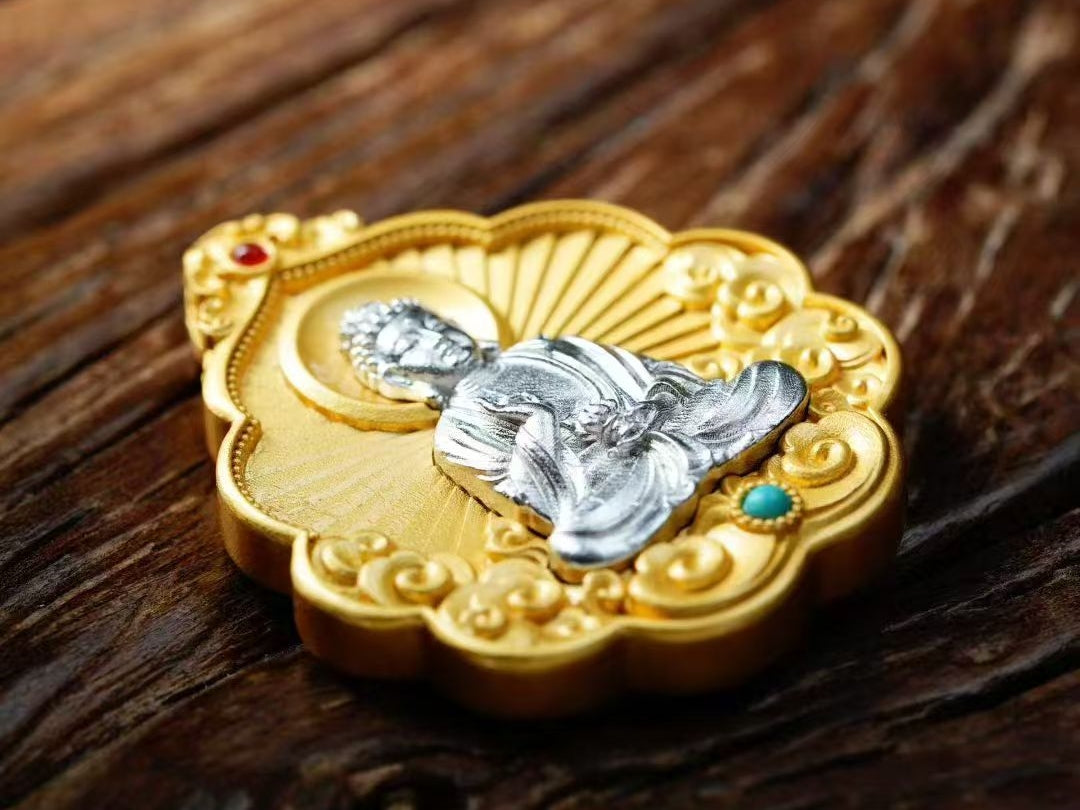A small ritual helps a sacred object arrive into your life with intention — whether it’s a hand-painted Thangka pendant, a brass gawu, or a sterling-silver amulet. Below is a gentle, practical unboxing and blessing routine that honors Tibetan practice without requiring formal training. It’s designed for everyday people who want to treat sacred pieces with respect and meaning.

Why an unboxing ritual matters
An unboxing ritual does three simple things: it creates a calm container for your attention, it marks the transition from commodity to meaningful object, and it invites you to form a conscious relationship with the piece. Intention, not theatricality, is what matters — a sincere two-minute practice is far more powerful than a long ceremony gone perfunctory.
Quick checklist (what to prepare)
You don’t need much. Keep things simple and sincere.
• A clean, quiet surface (table or altar)
• A soft cloth or small tray to place the pendant on
• A small bowl of clean water (for symbolic offerings)
• One flower or a few drops of essential oil (optional)
• A single lit incense or a candle (if you use flame safely)
• A short dedication (see sample below)
Simple 3-minute ritual — for busy days
-
Find calm. Take three slow breaths to settle. Put away phones and distractions.
-
Open with respect. Unwrap the package slowly. Place the pendant on the cloth or tray. Notice its weight, color, and details.
-
Offer water and flower. Set the small bowl of water beside the pendant and place the flower near it. These are simple, cross-cultural signs of welcome.
-
Set an intention. Silently state a short intention out loud or in your mind (e.g., “May this object remind me to be kind and present.”).
-
Short dedication. Recite the sample dedication below (or one of your own).
-
Close gently. Blow out the incense or candle (if used), fold the cloth around the pendant, and place it on your altar or in a safe drawer until you wear it.

A fuller 10-minute ritual — for those who want more
-
Clean the space. Wipe the surface and arrange the tray, water, and flower. Sit comfortably.
-
Grounding breath. Breathe slowly for five rounds, allowing your shoulders to relax.
-
Examine the object. Hold it briefly in both hands. Appreciate the artisan’s work and the materials.
-
Three-part dedication. Speak or think: (a) For myself — what I seek (calm, protection, clarity); (b) For others — an intention of benefit; (c) For the object — gratitude to the maker and tradition.
-
Mantra or silence. If you have a short mantra you use (even simply “Om” or “Om Mani Padme Hum”), repeat it three to seven times. If not, sit in silence for a minute.
-
Offer and place. Offer the water and flower, then place the pendant in its intended spot (altar, shrine box, or a safe drawer for later wearing). Finish with three mindful breaths.

A short sample dedication you can use
“May this object support my practice and remind me to act with kindness. May its blessing spread to those I love. I receive it with gratitude.”
(Shorter: “May this blessing bring calm and protect my mind.”)
Practical etiquette & care tips
• Wear with respect: If the piece carries a deity image or a mantra, wear it close to the heart and avoid treating it like a fashion prop.
• Remove for bathing or exercise: Water and sweat can damage painted or inlaid pieces.
• Cleaning: Use a soft, dry cloth. Avoid harsh chemicals on pigments or patina. For hand-painted gawu boxes, keep them dry and out of strong sunlight.
• Storage: When not worn, keep the piece wrapped in a soft cloth in a dry box or your altar.
• Learn the meaning: A quick note about what the image or mantra represents deepens respect and connection.
Cultural sensitivity note
Many Tibetan objects are devotional items. If an artifact includes a sacred image or a consecrated mantra, treat it as a practice support rather than mere decoration. If you’re unsure about a particular symbol or proper handling, a brief conversation with the seller, a teacher, or a knowledgeable practitioner helps you act respectfully.
When to seek a teacher or a formal blessing
A short personal dedication is enough for most modern owners. If you believe an object has been ritually consecrated (or you plan to use it as the focus of an intensive practice), consult a qualified teacher for guidance on blessings or empowerments. That keeps practice safe and culturally appropriate.
Closing thought
Unboxing a sacred object is an invitation — to slow down, form intention, and bring a bit more presence into daily life. Even a few mindful breaths and a simple dedication make a new pendant feel like more than jewelry: a quiet reminder of what matters.




